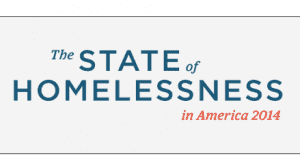 A radical change and new thinking in how states address homelessness has fueled a 17 percent decline in homelessness since 2005 – a trend that has withstood financial panic, a foreclosure crisis, and the Great Recession.
A radical change and new thinking in how states address homelessness has fueled a 17 percent decline in homelessness since 2005 – a trend that has withstood financial panic, a foreclosure crisis, and the Great Recession.
“Instead of trying to fix all the problems that homeless people have while they are homeless, [housing first] gets them into housing right away, then they end up taking care of a lot of other problems from a stable home”.
An Editor’s Pick article in the Christian Science Monitor comments on t new data come from the National Alliance to End Homelessness which sees the recent success as the “giant untold story of the homelessness world,” according to Stephen Berg, vice president of policy and programs.
The shift comes as the prevailing wisdom that homeless individuals need to get a handle on other social problems in their lives before they can receive housing gives way to new thinking. In recent years, many states have started to flip that idea and have adopted what’s known as a “housing first” approach.
It points to an openness to new ways to address persistent problems.
“It’s always hard when you see a big national change to give credit to one thing for it,” Berg says. “But I think communities are changing the way they are arraying their homeless resources and that’s got to be part of what’s bringing this trend about.”
Utah’s Department of Housing and Community Development has used the housing-first approach to slash chronic homelessness by 73 percent since 2005, says HCD director Gordon Walker.
“We used to say to people, ‘Change your life and then we’ll give you housing,’ ” Mr. Walker says. “We changed that to, ‘We’ll give you housing, and if you want to change your life, that’s up to you.’”
Walker insists that housing first makes perfect fiscal sense.
“By doing this, we actually save money.” Walker says. “If we house an individual, it costs about $12,000 a year; if we leave them on the street it costs society about $20,000 a year in emergency room services, incarcerations, polices interventions, and cleanup.”
The US Interagency Council on Homelessness has been advocating for housing first since the 2010 launch of Opening Doors, a federal strategic plan to prevent and end homelessness, says council Executive Director Laura Zeilinger.
This has been a major focus of the federal Veterans Affairs Supportive Housing program, Ms. Zeilinger says.
That effort has paid off, with a 24 percent reduction in homelessness among veterans and a 30 percent decrease in unsheltered homelessness among veterans from 2010 to 2013, she says. [Editor’s note: This paragraph has been updated to reflect the correct the percentage of decrease in unsheltered homelessness among veterans.]
“We’re showing that when we invest and we use those resources strategically, this is a problem we can solve,” Zeilinger says.
However, the housing-first approach only works if there is enough affordable housing to go around.
In Boston, housing is so tight that it is not uncommon for people to wait four to 10 years for affordable housing, says Kelly Turley, director of legislative advocacy for the Massachusetts Coalition for the Homeless.
Massachusetts is one of 20 states that reported an increase in homelessness from 2012 to 2013.
“Over the past year, Housing and Community Development saw an all-time high in terms of families that they were servicing through emergency housing programs,” Ms. Turley says.
The increased need for emergency housing has become so great that the state has had to resort to placing families in motels because there are not enough shelters.
“As of last Friday, there were 4,400 families living in shelters and motels, and of those, 1,891 were living in motels,” Turley says.







0 Comments